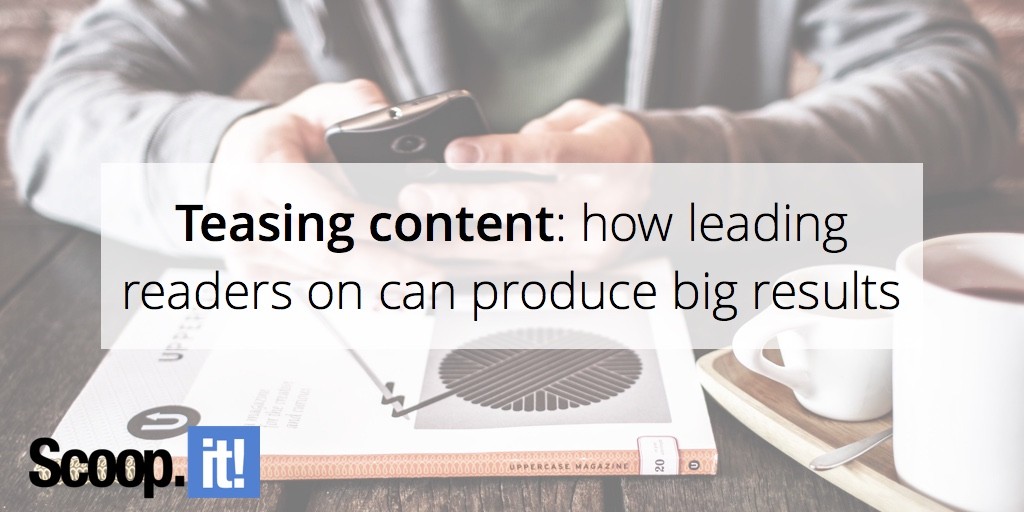
Nobody likes a tease in real life, but it can be quite powerful in the world of digital marketing. By teasing content, you can ignite curiosity and draw people in who otherwise wouldn’t give your content a second look. It’s a powerful technique that today’s leading content marketers are using with tremendous results – and so should you!
The science behind anticipation
Anticipation is a powerful emotion. It’s rooted in the portion of the human brain that’s known as the cerebellum. This is the area that controls automatic, “non-thinking” behavior – and it’s continually craving dopamine.
“Dopamine is a chemical neurotransmitter,” marketer Neil Patel explains. “It’s released from the brain’s frontal lobe and acts as a stimulant that prevents pain, stimulates arousal and causes excitement. Dopamine stimulation happens when we experience and expect good things. Anticipating positive events sustains the output of dopamine into the brain’s chemical pathways.”
What do anticipation, the cerebellum, and dopamine have to do with content marketing? Well, a lot more than you may think. If you’re able to use content to conjure up anticipation in your readers, suddenly you have leverage that can be used to your advantage in the pursuit of driving conversions.
“Psychology is the driving force behind conversion optimization. How people anticipate things powerfully shapes how they will interact with your landing page or conversion funnel,” Patel says. “The greater your grasp on the psychology of anticipation, the better you will be able to create a killer landing page [or other content] that ushers in higher conversions.”
4 tips for teasing content
In the context of content marketing, the best way to build anticipation is to tease your content. We’ll keep things PG here, but picture it like a striptease at a nightclub. There isn’t much finesse in immediately revealing everything. Dancers know they can earn more by slowly teasing the audience and stringing them along. The same is true in marketing. There’s more to be gained from teasing your audience and drawing them in.
Learning to tastefully tease content is a skill that marketers must work on acquiring. Having said that, these tips and pointers are extremely helpful.
1. Create gated content
As you’re most likely aware, gated content refers to any type of content that’s guarded behind a form. It’s content that requires a user to provide information – typically an email address – in order to be consumed. Not only is it valuable in the sense that it’s a great lead generation tool, but this type of content also tends to be highly effective because of how well it builds anticipation.

Image source: Pixabay
Gated content works well when you create a funnel that requires the user to move through a couple of different stages before they’re able to download or access the content.
“There is an art as well as a science to making people want to buy in to what you have to give them. If we want people to really build excitement about our content the art lies in the build-up,” marketer Gina Balarin says. “So that by the time the reader gets to the content, they’re excited about it. They’ve been taken on a journey towards downloading this content. And the destination is even sweeter as a result.”
2. Use offline mediums to reel in traffic
While we operate in a business world that’s totally dominated by digital marketing, this doesn’t mean offline marketing has completely gone by the wayside. In fact, if you can find ways to merge your online and offline efforts, the results can be powerful.
One way to build offline anticipation that hopefully converts online is to tease customers with some sort of printed content in a highly trafficked area. For example, try printing flyers and posting them at a college campus, bus stop, coffee shop, etc. On the flyer, you can tease whatever it is that you’re trying to market and then use a call-to-action to get people to visit a specific landing page. You may also use a QR code if your testing shows that your target market uses them.
3. Lead on with social media
There’s a difference between building anticipation and developing clickbait content. Facebook is cracking down on the latter and you need to be sure you aren’t spamming your followers. Understanding this, there are some pretty useful ways to tease your followers by leading them on.
The classic example of this is sharing a piece of content and using a call-to-action in the description. So, you may post a link with a headline that reads, “The Best Kept Secret to Obtaining Smooth Skin.” Then in the description, you write a couple of sentences with a statement at the end that reads: “Do you want to discover what it takes to finally enjoy smooth skin?” Most people will click to find out more
4. Try your hand at video
Video is quite powerful and effective right now, especially when used on social media. You can use video to tease content and pull people in as they scroll through their newsfeed.
If you have a webinar or feature video, you can try gating this content and pulling out a couple of 30-second clips that are particularly enticing. Share these clips on social media and add subtitles (in case the browser is on silent). Use a call-to-action at the end and you’re good to go. It’s a simple, yet effective tool for reaching people through the noise.
Take your readers on a journey
Anticipation is something we’re innately familiar with. While we may think – in the moment – that we want to forgo the delay and immediately experience whatever is awaiting us, this isn’t true. The anticipation is half of any experience – and we sometimes crave the buildup more than we do the actual thing.
The more you understand this, in terms of marketing, the more effective you can be in the execution of your content strategy. It’s not always easy, but learning how to tease your content will be hugely beneficial down the road. Learn this skill now and pull it out when you need it most.
Image by Maliha Mannan



